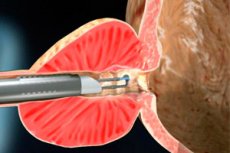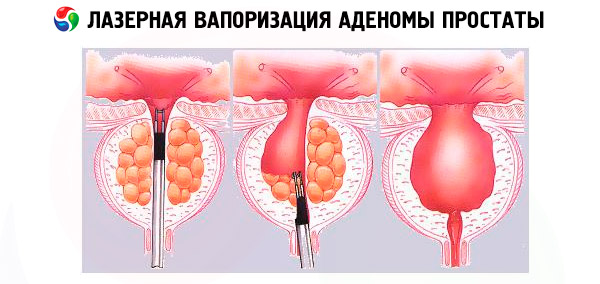Vaporization of the prostate: laser, plasma
Last reviewed: 23.04.2024

All iLive content is medically reviewed or fact checked to ensure as much factual accuracy as possible.
We have strict sourcing guidelines and only link to reputable media sites, academic research institutions and, whenever possible, medically peer reviewed studies. Note that the numbers in parentheses ([1], [2], etc.) are clickable links to these studies.
If you feel that any of our content is inaccurate, out-of-date, or otherwise questionable, please select it and press Ctrl + Enter.

With age, many men develop prostate gland and diagnose its benign hyperplasia, causing problems with urination. And today one of the methods of its treatment is endoscopic vaporization of the prostate.
What it is? In the case of urology, this is a local effect on the expanded tissue of the gland of a focused flow of thermal or high-energy photons that destroy the covalent bonds of atoms in protein molecules of prostate tissue, oxyhemoglobin and extracellular fluid, resulting in atoms losing their electronic shells and becoming positively charged ions, and the substance itself turns into gas, that is, evaporates.
Indications for the procedure
Vaporization - transurethral electrovaporization, endoscopic laser or plasma - is performed with prostatic adenoma, i.e. Benign prostatic hyperplasia, which has reached a stage not amenable to other methods of treatment.
Evaporation or removal of the prostate adenoma by the laser is indicated in cases when its size does not exceed 80 mm.
Both clinical studies and reviews of practicing urologists confirm the advantages of data from endourologic minimally invasive techniques in comparison with open and laparoscopic prostatectomy or transurethral resection of the prostate.
 [1]
[1]
Preparation
For any patient, vaporization of the prostate can be prescribed after her hyperplasia has been diagnosed during a full-scale clinical examination with transrectal ultrasound, uroflowmetry and blood testing for prostate-specific antigen (PSA), and in the presence of symptoms consistent with the International Prostate Symptom Score IPSS).
Read more - Diagnosis of prostate adenoma
A preparation directly to the procedure of vaporization involves the submission of a general blood test, a test for the rate of blood clotting, a general urine test and an ECG.
The patient for two days before the scheduled operation should stop taking anticoagulants and heparin preparations, and for 10-12 hours - food and liquids.
Technique of the vaporization of the prostate
Vaporization of the prostate adenoma is performed through the urethra, that is, transurethral - using a cystoscope, under local spinal anesthesia (sometimes under general anesthesia).
The technique of conducting transurethral electrovaporization of the prostate consists in the introduction through the urethra of the electrode, which is moved to the surface of the prostate gland. The electric current fed through it heats and evaporates the gland tissue; the affected area is washed with saline solution; At the same time, blood vessels are coagulated and sealed. For the outflow of urine for a day or two, a catheter is installed.
The basic techniques of laser surgery for prostate adenoma include a minimally invasive operation under endoscopic control - laser vaporization of the prostate adenoma or layer-by-layer removal of the prostate adenoma with a laser lasting no more than 50-60 minutes. Depending on the equipment used, the technique can be contact and non-contact (with the lateral direction of the beam through the quartz caps STL, Ultraline, Prolase-I), used for adenomas of a larger size.
High-power diode lasers such as YAG, Quanta System, GreenLight (KTP-laser with a power of 60 W or LBO GreenLight HPS with a power of 80 W) are used for contact vaporization-direct contact of the light guide with a cloth. When the laser beam penetrates, thermal conversion of laser energy takes place, which leads to an increase in the temperature of excess prostate tissue above the boiling point and its immediate evaporation.
Photo-selective laser vaporization of the prostate (using the GreenLight XPS laser) uses several energy pulses lasting from 30 to 60 seconds under which the destruction of hyperplastic prostate tissue and a decrease in its size occurs. This method is used even in the presence of patients with heart problems (since local anesthesia).

The bipolar plasma vaporization of the prostate in physiological saline (bipolar plasma-kinetic technology) is a high clinical efficiency and a sufficient degree of safety. It is the removal of prostate tissue using low-temperature plasma energy (produced by generators, for example, Olympus UES-40 Surgmaster), which is delivered through special devices that do not contact directly with the prostate gland. Electricity flows between the electrodes, converting the concentrated saline solution into a layer of plasma that destroys the tissue upon contact.
Plasma vaporization not only evaporates the overgrown tissue, but also coagulates the remaining healthy tissue, leaving a smooth surface. Plasma evaporation with a button (mushroom) electrode of a spherical surface provides better coagulation. The operation is performed under epidural anesthesia.
Contraindications to the procedure
Among the contraindications to the operation are:
- infectious diseases;
- the presence of chronic inflammatory diseases of the urinary tract and pelvic organs;
- unstable cardiopulmonary status of the patient;
- recently transferred myocardial infarction or stent of the coronary artery (in such cases, the operation is postponed for 3-6 months);
- serious coagulopathy (including congenital), requiring the constant use of drugs to increase blood coagulability;
- hyperactive bladder and / or lower urinary sphincter dysfunction;
- myasthenia gravis, multiple sclerosis, Parkinson's disease;
- diabetes mellitus in severe form.
 [4]
[4]
Consequences after the procedure
Possible and such consequences after the operation, as:
- impaired sperm output, that is, its reverse flow (to the bladder) or retrograde ejaculation, which reduces male fertility;
- erectile disfunction;
- repeated proliferation of the prostate (relapse of benign hyperplasia) for several months after the operation.
Complications after the procedure
Bleeding during and after laser and plasma vaporization is minimal, and the healing process proceeds quickly, but there may be complications after surgery:
- temporary internal edema of the tissues, complicating urination;
- minor pain in the urethra and in the suprapubic region;
- burning in the urethra (especially after removal of the catheter);
- hematuria (blood in the urine for a few days or two weeks);
- frequent urge and incontinence;
- burning at the tip of the penis and discomfort at the end of urination (two to six weeks);
- infection of the urinary tract;
- formation of scar tissue in the urethra causing its obstruction.
The complication of spinal anesthesia can be a headache.
Care after the procedure
The recommendations of the European Association of Urology specialists on the care after vaporization of the prostate are as follows:
- should avoid physical exertion (sports, lifting weights, riding a bicycle) and sex for at least two weeks;
- Do not take baths, do not visit the pool and do not swim in the water;
- when pains take painkillers or NSAIDs, and in case of inflammation - prescribed by a doctor antibiotics;
- for a while to exclude the use of coffee, tea, carbonated and alcoholic beverages, citrus juices, spicy and fatty foods;
- daily during the first weeks after the operation, drink up to 1.5 2 liters of water;
- To avoid constipation, include more fiber in the diet.

